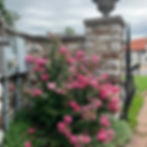
Resilient gardens, landscapes, and green spaces are meticulously planned and tended to in order to flourish with minimal reliance on resources like irrigation, fertilizer, and pesticides. Achieving resiliency involves a comprehensive approach that considers the overall site, plant relationships, regional climate, and other relevant factors, rather than just isolated elements. It is common for the aesthetic appeal or maintenance requirements to overshadow the fundamental purpose of the plants, gardens, or spaces being developed.
Resilient gardens effortlessly transform into versatile spaces for entertainment, relaxation, and engagement. They provide individuals with the opportunity to immerse themselves in nature, whether it's observing a monarch butterfly alighting on a milkweed plant or witnessing a box turtle exploring a newly installed dry creek bed.

Will this plant live longer than 30 years? Will this garden handle the stormwater runofff from my property or my neighbor’s? Will this garden or plant survive if I stop watering completely? What are my annual costs for maintaining my new resilient garden? Who will be performing the seasonal maintenance? By asking yourself these questions and continuing your inner dialogue, you can begin to understand that 21st century gardening, horticulture, landscaping (whatever you call it), requires much more than wanting colorful flowers or knowing when a plant blooms or when a tree drops it’s leaves.
In contemporary gardening and horticulture practices, a comprehensive knowledge of soil, plant species physiology, stormwater runoff, entomology and understanding environmental variables is essential for maintaining the vitality of gardens and plants.
For instance, in the region of St. Louis, MO the occurrence of late winter freezes poses a potential threat to star magnolia trees. Magnolia stellata is among the earliest flowering magnolias in this area, typically blooming in early spring when temperatures can still drop below freezing during the night and early morning hours.

This serves as one of many instances where non-native plant species can survive, but their ability to thrive and function optimally in a resilient green space may be compromised. Another example of a common garden plant is the big leaf hydrangea, scientifically known as Hydrangea macrophylla. While numerous cultivars are now accessible, some of the oldest ones have been in existence since the early 19th century. It is noticeable that many traditional (1900’s) big leaf hydrangeas in St. Louis gardens tend to exhibit unreliable flowering compared to their past performance. The occurrence of late winter or early spring, sub-zero temperatures in our region often results in the complete die-back of stems to the crown. Although the crown typically remains unharmed, the realization that older cultivars of Hydrangea macrophylla exclusively bloom on old wood may prompt the decision to transition to a new cultivar or opt for a native plant altogether.
An additional instance demonstrating the lack of resiliency in non-native vegetation is evident in certain areas of Southern Virginia and other southern U.S. sates, where a significant infestation of crapemyrtle bark scale (Acanthococcus lagerstroemiae) is causing a decline and subsequent loss of the formerly esteemed ornamental tree species originating from Asia. This plant is often used throughout the Midwest as well. As the winter temperatures can drop below 0F, crapemyrtle often dies to the ground and resprouts from the crown the following Spring. So, in this instance they are grown as shrubs and not as trees. The attractive bark on its mature stems is one of the highlights to grow this plant in a winter garden.

Indigenous plants in your region are inherently well-adapted to the specific conditions of your residential and commercial gardening areas. This is due to their long history of evolution over hundreds, if not thousands, of years in these regions. Furthermore, the insects, birds, and animals that interact with these plants, either by consuming them, using them as a host for their larvae, or seeking shelter in them, have also co-evolved alongside these plants.



